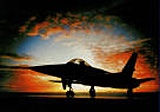|
|
|
|
|
| "Grumman Rakecat" |
| (scratch from odd
parts) |
|
|
| |
|
|
This model
was created before Grumman Inc. unveiled their X-29!
In the late 70's of the 20th century "AIR
International" news talked about a "Supersonic Cruiser" Grumman had in work. A
novel feature being forward swept wings. I wondered what it would look like. Would Grumman use two
engines (safer flight but more weight and therefore more fuel consumption)?
No, I thought, this would also put more load on the wings and therefore present
more risks. So a slender fuselage with one engine. Wing-fuselage joint naturally with minimum
induced drag, blended therefore. The (then) newest invention,
fly-by-wire, led to forward mounted control surfaces (the second vertical one
under the forward fuselage according to latest calculations - "CCV" control
configured vehicle - about possible
movements, in reality soon to be discarded).
So how to make...? I found an old 1/48 F-5.
The forward fuselage seemed just right. Rear fuselage from a F-100 as well as
the wings, front edges after some sanding becoming the rear ends. F-5 elevators
could be used as they were, an A-5 vertical stabiliser as well. Remained the air
intakes. After some thinking about compressor stall and other airflow problems I
came out with an A-5 solution, because this seemed best for maintaining air flow
under high incidences. Undercarriage (being not so important) from Revell B-58
(front) and F-100 (main). Remained the blending of the wings into the fuselage: Several layers of
putty (all at once would have softened the plastic too much). Cockpit interior by
imagination, canopy as usual clear PVC (see page C).
For a Grumman plane naturally it had to be
Navy and because of the forward swept - raking - wings the name "Rakecat" seemed
appropriate.
"Modellmagazin" didn't take this effort too
serious and therefore the article appeared some time after rollout of the real
Grumman airplane. I was furious! Nobody would believe my invention by now. - On the
other side (admittedly) I was very proud, for the real thing wasn't far away
from my calculations (just the rear end of the wings differing somewhat).
General thoughts and tips for modeling see "Modelling
ABC"


